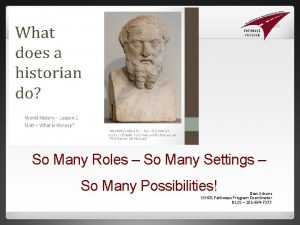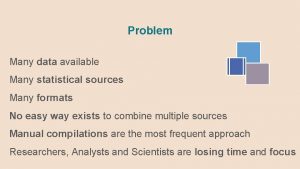MODERN ART What is Modern Art Many people








- Slides: 8

MODERN ART

What is Modern Art? Many people think modern art is “abstract art” or art that “shows feelings rather than things”. We don’t define modern art by technique or style. So, how do we define modern art? We define it as the art produced in North America and Europe from the time of the Impressionists (1860’s) up to the middle of the twentieth century (1970’s). This period is important because many artists worked in new and exciting ways that challenged traditional ideas about what art is and what it could be. It's true that many of these new, innovative artists explored the possibilities of using art not only to make representations of objects, people and landscapes but as a way of expressing feelings, emotions, atmospheres and dreams. It is also true that many of the techniques they invented might seem basic or even random at first. Many of these artists were initially more concerned with experimenting and exploring the possibilities of the materials themselves, without wanting to express or represent anything.

Let’s take a look at some examples of famous Modern Art pieces! “Water Lilies” (1896– 1926) By: Claude Monet This art piece focused on capturing the momentary effect of a scene rather than accurately depicting it. This is 1 of approximately 250 oil paintings which were created by Monet during the last 30 years of his life. “The Persistence of Memory” (1931) By: Salvador Dali This iconic painting depicts a scene with watches melting slowly on rocks and the branch of a tree; with the ocean as a backdrop. Dali uses the concept of hard and soft in this painting. It can be illustrated in a number of ways like the human mind moving from the softness of sleep to the hardness of reality.

“The Rose Marble Table” (1916), By: Henri Matisse With its extraordinary tilted tabletop holding a basket and three apples, this painting shows Matisse’s interest in playing with different perspectives. “The Starry Night” (1889), By: Vincent Van Gogh, who had a struggle with mental illness, admitted himself to the Saint-Paul asylum in Saint-Rémy-de-Provence in France on May 8 th 1889. Although painted during the day, this masterpiece depicts the night view outside the window of Van Gogh’s room at the asylum. The Starry Night shows the artist’s interest in astronomy and a study made by the Griffith Park Observatory demonstrated that Vincent represented the Moon, Venus, and several stars in the exact position they occupied that clear night.

“Vir Heroicus Sublimis” (1950– 51) By: Barnett Newmane Measuring 18 feet long and eight feet high, this canvas was meant to overwhelm the viewer’s senses, and indeed, it does just that, especially if you view the painting as the artist intended: up close with your nose practically in it. This painting isn’t about the artist’s emotions captured in a gesture but rather about the viewer’s emotional response while confronting it. Number 1 A” (1948), Jackson Pollock This is the first work in which the Abstract Expressionist completely abandoned the easel, laying the canvas on the floor of his studio, throwing oil paint on top of pools of industrial house paint.

VIRTUAL FIELD TRIP! Today we will be going to…. THE MUSEUM OF MODERN ART! While visiting the museum, take a look at all of the unique modern art pieces around you. When you click on a certain art piece, you will be able to read information on it, play games based on it, explore fun activities and learn some fun facts! You can even take the elevator to the second floor to see what Modern Art awaits! After visiting the museum, you will complete the chart on the next slide. You may want to read the instructions before visiting the museum so that you know what information to look for! Honk! It sounds like the bus is here! Hop on and let’s go…. . …

WE’RE HERE! Click on the door handle to enter the museum.

Task: After visiting the Museum of Modern Art, choose 4 art pieces that stood out to you most and fill out the chart below. Famous Artists 1. 2. 3. 4. Name of art piece and year or country of origin 2 Interest Facts about the art piece Why did this art piece stand out to you?















